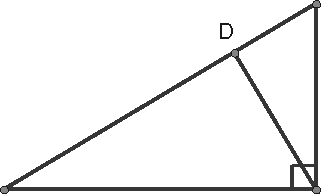Geometry: The Pythagorean Theorem
The Pythagorean Theorem
Now that you know how to show that two triangles are similar, you can use CSSTAP to find relationships between the sides of similar triangles. You can even create the theorems necessary to prove one of the most famous theorems in geometry: the Pythagorean Theorem. But before you can tackle the Pythagorean Theorem, you'll need a theorem about altitudes. I'll walk through an explanation of why the theorem is true, but I will not write out a formal proof.
- Theorem 14.1: The altitude drawn to the hypotenuse of a right triangle separates the right triangle into two right triangles that are similar to each other and to the original right triangle.
Figure 14.1 will help clarify what is going on. The altitude drawn to the hypotenuse has to originate at the vertex of the right angle (C) and is perpendicular to the hypotenuse (¯AB). Let's call the point where the altitude and the hypotenuse intersect D. You have three triangles to relate: the original triangle ΔABC and two new, smaller triangles ΔACD and ΔCBD. Remember, you have to be careful about the order of the vertices. You have to match up corresponding vertices when representing the similarity of two triangles. You can use the AA Similarity Theorem and the transitive property of similarity (remember, similarity is an equivalence relation) to show that all three triangles are similar.

Figure 14.1ΔABC with altitude ¯CD from C to the hypotenuse ¯AB.
First, I'll show that ΔABC and ΔCBD are similar. Both triangles are right triangles, so there's one pair of congruent angles. As for the second angle, notice that ∠B is involved in both triangles. Because ∠B ~= ∠B, you've got a second pair of congruent angles, and by the AA Similarity Theorem, ΔCBD ~= ΔABC. You need to match up your angles and your vertices: ∠D is the right angle in ΔCBD, which corresponds to ∠C in ΔABC, ∠B corresponds to itself, and ∠BCD corresponds to ∠A.
You'll use a similar argument to show that ΔABC and ΔACD are similar. ∠D is the right angle in ΔACD, so it corresponds to ∠C in ΔABC. ∠A corresponds to itself, which leaves ∠ACD and ∠B to correspond.
Because ΔACD ~ ΔABC and ΔABC ~ Δ CBD , the transitive property of ~ shows that ΔACD ~ ΔCBD. Because CSSTAP, you know that
- AD/CD = CD/DB.
This should look a bit familiar. From this proportionality, you see that CD is the geometric mean of the lengths of the segments of the hypotenuse! The Pythagorean Theorem is just a couple of algebraic steps away.
Now that you know these three triangles are similar, you can break them apart to get a better handle on the proportionalities involved. You might want to refer to Figure 14.2.

Figure 14.2ΔABC can be split into two triangles: ΔACD and ΔCBD. All three triangles are similar.
Because ΔACD ~ ΔABC, you know that
- AB/AC = AC/AD.
Because ΔABC ~ ΔCBD , you know that
- AB/BC = BC/BD.
If you cross-multiply, add the two equations together, and simplify, you will derive the Pythagorean Theorem! I'll write out the details in a two-column proof.
- The Pythagorean Theorem: The square of the length of the hypotenuse of a right triangle is equal to the sum of the squares of the lengths of the legs.
Translating the Pythagorean Theorem into the drawing in Figure 14.2, the goal is to prove that (AB)2 = (BC)2 + (AC)2.
| Statements | Reasons | |
|---|---|---|
| 1. | ΔACD ~ ΔABC and ΔABC ~ ΔCBD | Previous discussion |
| 2. | AB/AC = AC/AD and AB/BC = BC/BD | CSSTAP |
| 3. | AD + BD = AB | Segment Addition Postulate |
| 4. | (AB)(AD) = (AC)2 , (AB)(BD) = (BC)2 | Means-Extremes property of proportionlity |
| 5. | (AB)(AD) + (AB)(BD) = (BC)2 + (AC)2 | Addition property of equality |
| 6. | (AB)[(AD) + (BD)] = (BC)2 + (AC)2 | Algebra (factoring) |
| 7. | (AB)[(AB)] = (BC)2 + (AC)2 | Substitution (step 3 and 6) |
| 8. | (AB)2 = (BC)2 + (AC)2 | Algebra |
That's the most algebraic proof of the Pythagorean Theorem! The next time you prove the Pythagorean Theorem you will use areas of triangles.
Excerpted from The Complete Idiot's Guide to Geometry © 2004 by Denise Szecsei, Ph.D.. All rights reserved including the right of reproduction in whole or in part in any form. Used by arrangement with Alpha Books, a member of Penguin Group (USA) Inc.
To order this book direct from the publisher, visit the Penguin USA website or call 1-800-253-6476. You can also purchase this book at Amazon.com and Barnes & Noble.







